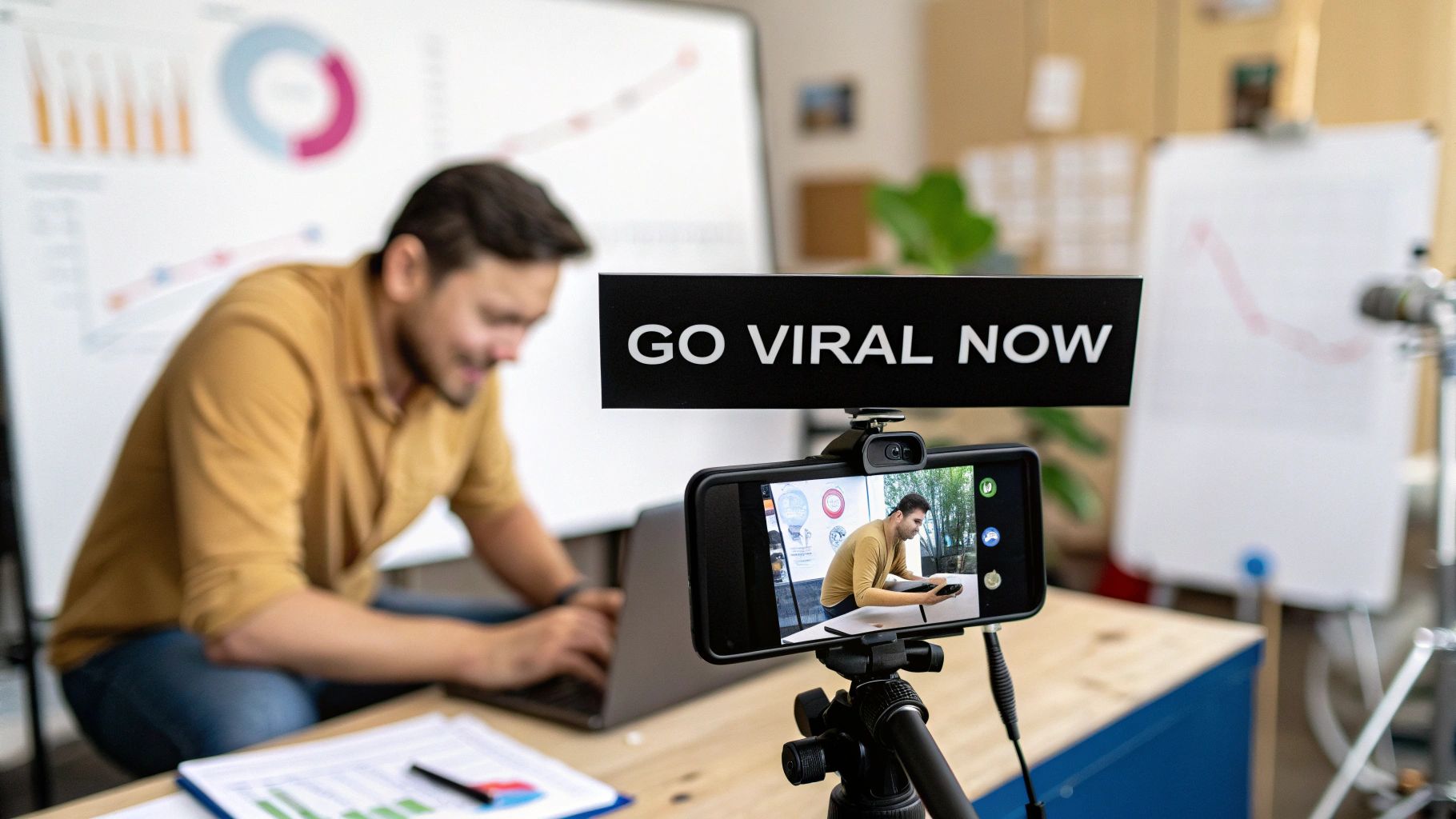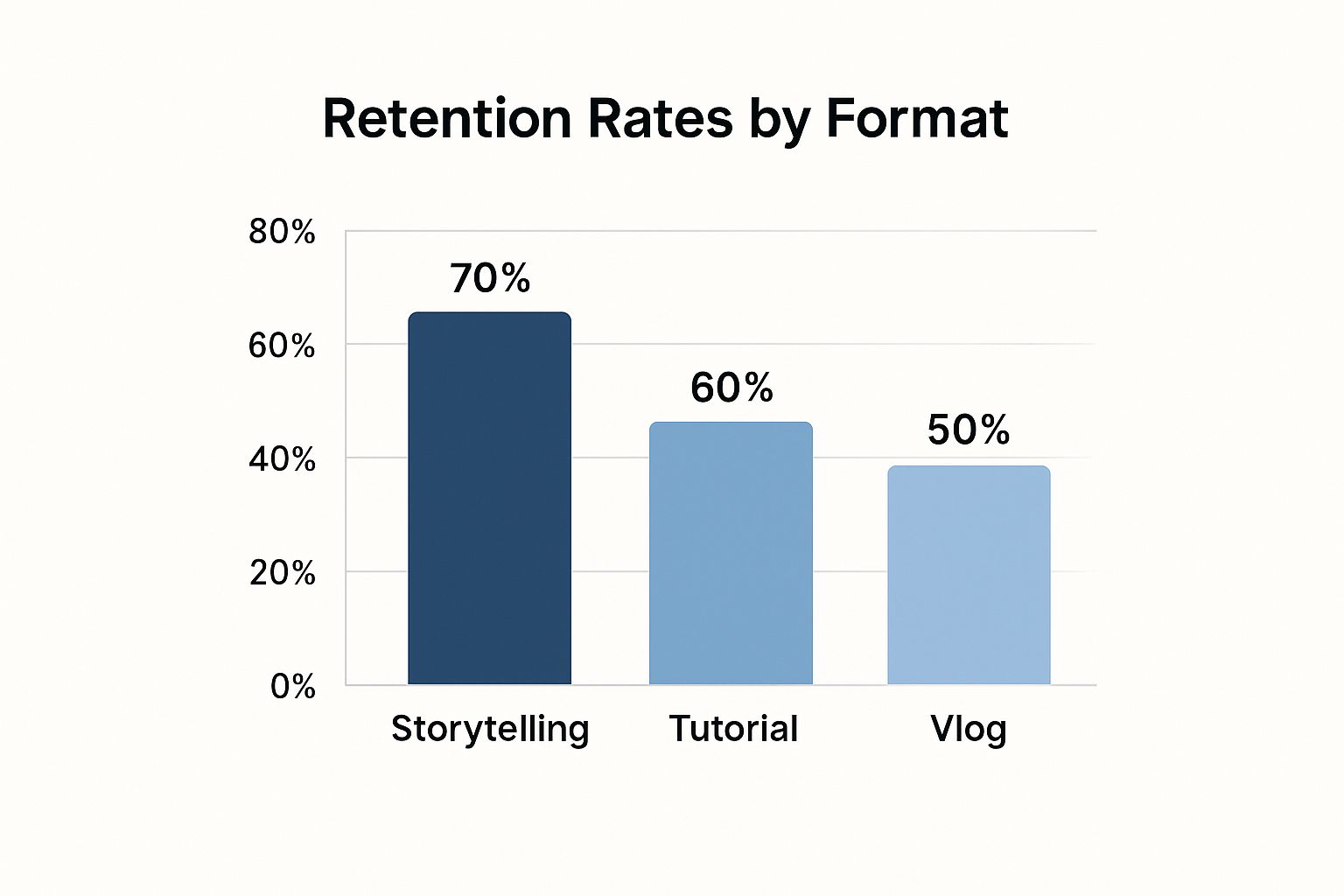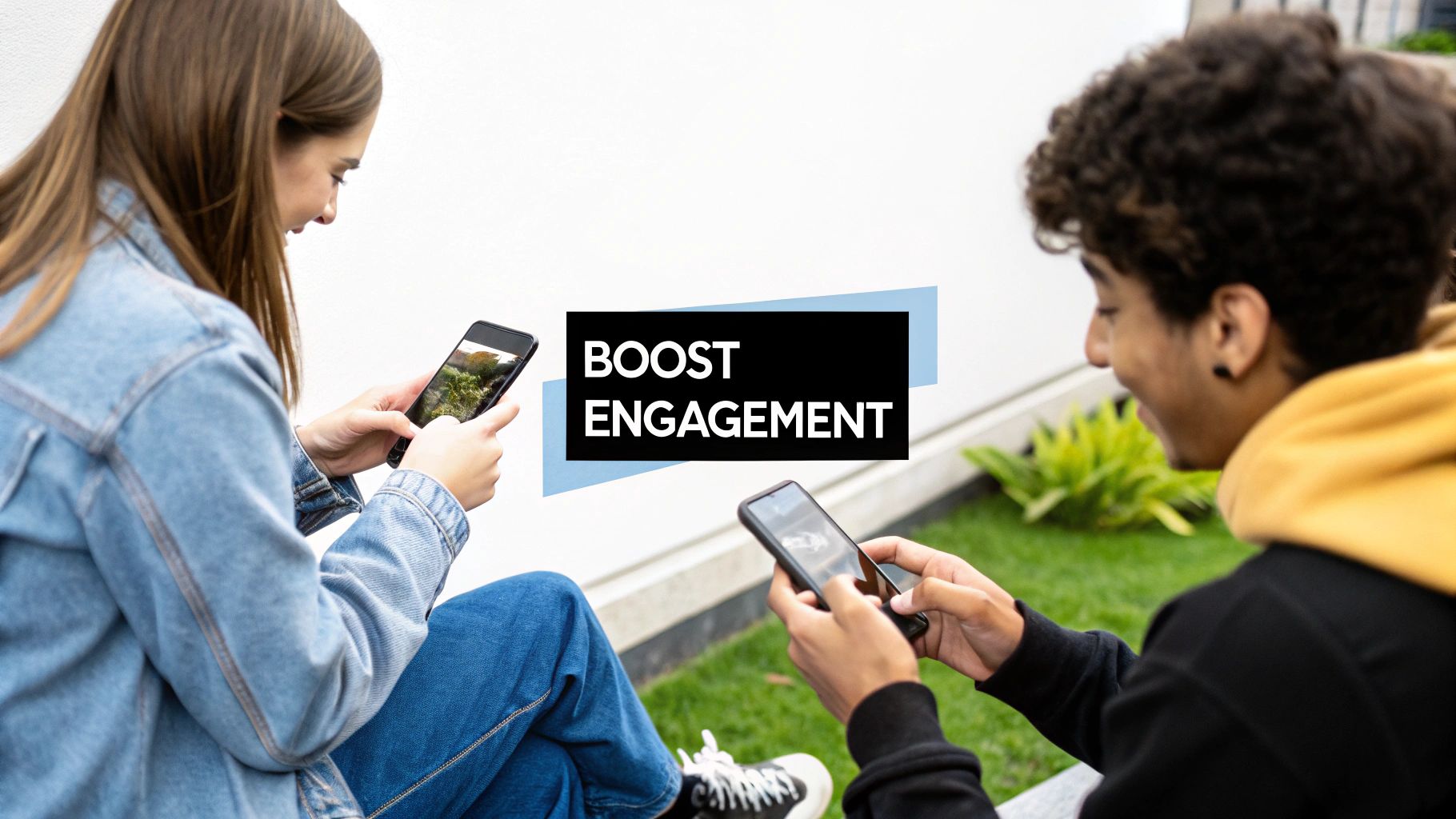Questions & Answers
We're here to help you get the most out of viral.app.
Mike Schneider
Co-Founder
Unlock the psychology and platform-specific tactics behind making your content spread like wildfire.

Let’s be honest: trying to make a video go viral can feel like capturing lightning in a bottle. You see two videos with similar production quality—one gets a million views, the other barely cracks a hundred. What gives? After talking with creators who consistently hit that viral jackpot, I've learned the secret isn't just luck. It's about understanding the deep-seated psychological triggers that make someone stop scrolling and, more importantly, hit 'share'.
The very idea of "viral" has changed. A few years ago, it meant a single quirky YouTube video everyone in the office was talking about. Now, virality is a complex system. It unfolds across multiple platforms at once, powered by algorithms that learn from our every move. A clip might explode on TikTok, get remixed on Instagram Reels, and spark a debate on X (formerly Twitter). It’s not one big bang; it’s a chain reaction of interconnected sparks.
At its core, sharing is a social action. People share content that reinforces who they are, helps their friends, or triggers a powerful emotion. Think about it: when you share a funny skit, you're showing you have a good sense of humor. When you share a "life hack" video, you're being genuinely helpful. This is the foundation of social currency—the idea that sharing cool, useful, or entertaining things makes us look good to our peers.
Viral content almost always plugs into one of these core human motivations:
This whole dynamic has been supercharged by the complete takeover of short-form video. We live in a world of quick hits and instant gratification, and our media habits show it. The numbers are mind-boggling; short-form video is on track to make up 82% of all internet traffic by 2025. This isn't just a fleeting trend; it's a fundamental shift in how we consume information.
The market itself tells the same story, growing from $1.97 billion in 2024 to a projected $3.55 billion by 2029. This data proves why getting good at platforms like TikTok, Reels, and YouTube Shorts isn't optional if you want your content to spread. You can find more data on these short-form video trends on Beaconinside.
Ultimately, figuring out what makes content catch on is less about chasing fleeting trends and more about connecting with basic human behavior. It’s about creating something that resonates so deeply that people feel an urge to make it part of their own story.
In the world of endless scrolling, you don't have minutes to win someone over—you have seconds. That initial moment, the first three seconds of your video, is the single most important part of your content. It’s the gatekeeper to the rest of your message. If you fail here, it doesn't matter how great the rest of your video is, because nobody will stick around to see it. Think of it as the ultimate elevator pitch, delivered in the blink of an eye.
So, how do you make someone stop mid-scroll? You need an immediate hook. This isn't just about a flashy opening; it's about creating an instant question, sparking curiosity, or presenting a visual that’s so unusual it demands attention. A great hook makes a promise. It could be promising a surprising outcome ("I tried the viral 'egg peel' hack, and you won't believe what happened") or a valuable piece of information ("Here's the one mistake everyone makes when cooking steak").
This is especially critical when considering how people watch videos today. Globally, over 75% of video views happen on mobile devices, often in environments where sound is off. In fact, research shows a staggering 85% of Facebook videos are watched without sound. This means your visual storytelling has to do all the heavy lifting from the very first frame. If your message relies on audio, it's already lost on a massive portion of your potential audience. You can discover more stats about video marketing behavior to better understand these viewing habits.
The type of hook you use can significantly impact viewer retention, which is a major signal to algorithms deciding whether to push your video. Different formats work better for holding attention across various platforms. What grabs an audience on TikTok might not work as well on Instagram Reels or YouTube Shorts.
To help you decide, here's a breakdown of what tends to capture attention in those first few seconds on each major platform.
| Platform | Optimal Hook Type | Visual Requirements | Audio Considerations |
|---|---|---|---|
| TikTok | Fast-paced, trend-based, or question-driven. Text overlays with a bold claim are very effective. | Bright, high-energy visuals. Often starts with a person speaking directly to the camera. | Trending sounds are crucial. The audio often sets the context before the visuals even register. |
| Instagram Reels | Aesthetically pleasing, cinematic, or a quick, satisfying "before-and-after" reveal. | High-quality, polished visuals. A clean and visually appealing scene is key. | Music is more important than dialogue. A popular song can be a hook in itself. |
| YouTube Shorts | Value-driven or a surprising result. "How-to" or "myth-busting" formats do well. | Clear and direct visuals that immediately show the subject of the video. Less polish needed. | Voiceovers explaining the setup or question work well, but on-screen text is still vital for silent viewers. |
This table shows that while the goal is the same—stop the scroll—the execution needs to be tailored. A high-energy, text-heavy TikTok hook might feel out of place on the more polished Instagram feed.
The infographic below shows a comparison of average retention rates by video format, highlighting which styles tend to keep viewers watching longer.

As the chart illustrates, storytelling hooks often lead to the highest retention because they create an open loop that viewers want to see closed. A tutorial promises a skill, but a story promises an emotional journey or a surprising resolution.
To effectively craft an opening that makes your video go viral, focus on a clear visual and a compelling, unspoken question. Test different approaches: start with the final result, pose a controversial question with on-screen text, or show a bizarre, attention-grabbing clip. Master these first few seconds, and you’ll have a much better chance of holding your audience until the end.

When was the last time you shared a video? Let me guess: it wasn't because of its perfect lighting or flawless editing. You hit that share button because it made you laugh hysterically, gasp in surprise, or feel a deep, comforting sense of "me too." That's the real secret to viral content. It's not about views; it's about feelings. A video that truly connects doesn't just get watched—it gets felt. That emotional reaction is what makes someone want to share it with their friends and make it part of their own online identity.
The most shareable videos tap into what psychologists call high-arousal emotions. These are the big feelings that jolt us and make us want to do something, like share. Sadness is an emotion, of course, but it's low-arousal and doesn't typically inspire a share. On the other hand, emotions like awe, surprise, and humor light up our brains. They create a powerful urge to pass that feeling along to someone else. If you can learn to create content that triggers these specific emotions, you've found your key to massive organic reach.
So, how do you make your audience feel something without coming off as cheesy or manipulative? It starts with deciding on the single, core feeling you want them to have. Is it the simple joy of watching a cat do something ridiculous? The mind-bending awe of a cool science experiment? Or the powerful connection that comes from a shared, relatable struggle?
Think of it as having an emotional toolkit. Here are a few must-haves:
Sometimes, getting a strong emotional reaction means pushing the boundaries. A look at recent trends shows that controversial or shocking content can be a shortcut to virality. For example, extreme challenges have pulled in tens of millions of views per video, with their hashtags collecting billions of impressions. In the same vein, reaction videos to intense VR horror games have scored over 10 million likes on a single clip. You can see more analysis on these TikTok viral trends to get a better sense of this approach. It's clear that high-stakes emotions grab attention like nothing else.
However, this is a double-edged sword. While controversy can definitely boost engagement, it can also attract negative attention and backlash. The trick is to find the line between being provocative and just being problematic. You have to know your audience and what they'll tolerate while staying true to your brand. Making a splash can be effective, but building a loyal community depends on an authentic emotional connection that feels earned, not forced.

It’s a common trap for creators: treating platform algorithms like some mysterious enemy you have to outsmart. But here’s the thing—algorithms aren't judging your artistic genius. They are complex systems built with a single goal in mind: to keep viewers on the platform as long as possible. Once you grasp this, you can shift from fighting a losing battle to working with them. Think of your video not just as content, but as a package of signals you’re sending to the system.
These platforms look for a few specific signals to decide if a video is worth pushing to a wider audience. The most important signal is watch time. A high completion rate is a clear message to the algorithm that your video holds people's attention, making it a safe bet to show to more users. Another powerful signal is early engagement. A burst of likes, comments, and shares in the first few hours tells the platform your content is sparking immediate interest. This is exactly why a dedicated community is so valuable—they give you that critical initial momentum.
While the basic idea is the same everywhere, what works on TikTok might not have the same impact on Instagram Reels or YouTube Shorts. Each platform prioritizes different signals. For a really deep dive into one of the major players, our guide on the TikTok algorithm explained breaks down exactly how that platform’s mechanics work.
To help you get strategic, it’s useful to see exactly what each algorithm values most when deciding to make a video go viral.
The table below breaks down the key factors that influence your video's reach on the major short-form platforms.
Key factors that influence video visibility and reach across major social media platforms
| Platform | Primary Factors | Engagement Weights | Timing Importance |
|---|---|---|---|
| TikTok | Watch Time & Completion Rate: The algorithm heavily favors videos that are watched all the way through or multiple times. | Shares & Saves: These are weighted more heavily than likes or comments, as they signal strong user intent. | Very High: Posting when your specific audience is most active is critical for initial traction. |
| Instagram Reels | Initial Engagement Velocity: Likes and comments in the first hour are crucial. Use of trending audio is also a major factor. | Comments & DMs: Interaction that sparks conversation is highly valued. | High: The first 24 hours are vital. Consistency in posting schedule is rewarded over time. |
| YouTube Shorts | Audience Retention & Click-Through Rate (CTR): How many people click to watch and how long they stay are paramount. | Likes & Subscriptions: Gaining a new subscriber from a Short is a powerful positive signal. | Moderate: While important, the "shelf life" of a Short can be longer, gaining views over several days. |
As you can see, understanding these differences is the first step. The next is to actively feed the algorithm the right kind of engagement. By tailoring your content to send the signals each platform is looking for, you move from guesswork to a strategic approach. If you're looking for more ways to get this right, you can find great strategies to boost social media engagement that apply across the board.
A one-off viral video can feel like a lucky break, but building a massive, engaged following is almost never an accident. It comes from creating something far more durable than a high view count: a real community. While algorithms are a huge part of the equation, they ultimately follow human behavior. When you build an audience that knows and trusts you, they do more than just watch—they become your best marketers, spreading your message for you. This is how you stop chasing viral moments and start building a system for them.
The most successful creators I've worked with never see their followers as just numbers on a screen. They view them as partners in the creative process. This shift in mindset means you start making content that asks for participation, turning someone from a passive scroller into an active part of the experience. The goal is to make your audience feel like they're in on an inside joke, a shared project, or a conversation that’s just getting started.
The trick is to weave the invitation to participate directly into the fabric of your video. Instead of presenting a polished, finished piece, think of your content as the first move in a conversation. Here are a few ways to get people involved:
This level of audience loyalty doesn’t appear overnight, and it takes more than just smart content ideas. You have to be present and engaged. Responding to comments, featuring content from your fans, and acknowledging your regulars are small gestures that build incredible goodwill. It's like taking care of a garden; you have to put in the work. A viewer who gets a personal reply from you is far more likely to comment again and share your next video.
When you take this approach, your audience transforms from a group of passive viewers into a community of active supporters. They share your content not just because they liked it, but because they feel connected to you and have a personal stake in your success. This creates a powerful multiplier effect that fuels consistent growth and is the real secret behind how to make a video go viral again and again.
It’s easy to get caught up chasing high view counts, but let's be honest, that's a classic vanity metric. Views tell you how many people glanced at your video, not how many were genuinely hooked. If you want to understand what makes a video truly go viral, you have to look past the surface-level numbers and focus on the data that shows real audience connection. The algorithms on these platforms are built to find and promote content that people actually engage with, and they're looking at a lot more than just the initial click.
Let’s set aside the total view count for a second. Instead, we'll zero in on the data that tells the real story of how viewers are behaving. These are the metrics that signal to platforms like TikTok, Instagram, and YouTube that your video is worth showing to more people. When you master these, you stop guessing and start making strategic moves based on how people are actually responding to your work.
Here are the key metrics you should be obsessing over:
The real breakthrough comes when you can turn these insights into a repeatable strategy. So, you've got a video that's performing well—don't just pop the champagne and move on. You need to dissect it. Create a simple framework to analyze what made it a hit. What was the hook? What specific emotion did it tap into? At what exact moment did you see a spike in engagement?
Recognizing these patterns is your first step toward building a content strategy that consistently delivers. You can learn more about how to evaluate these efforts by looking into the ROI of influencer marketing, as many of the same principles for tracking performance apply directly to your own content. When you systematically analyze what works, you're no longer hoping for a hit—you're building a predictable path to creating viral content again and again. Platforms like viral.app provide the deep AI-powered analytics needed for this, helping you move from guesswork to a predictable strategy.
It's time to put all this theory into action. Making a video pop off isn't just about getting lucky; it's about having a solid strategy. This action plan is designed to help you build a repeatable process, turning your creative shots in the dark into calculated viral moments. The goal is to shift from just making content to actually engineering videos that are built to be shared.
Before you even think about hitting that publish button, run through this quick mental checklist.
Think of each of these elements as a signal you're sending to the algorithm. You're essentially telling it, "Hey, this content is quality stuff, show it to more people!" A little focus here goes a long way.
Once your video is out in the wild, your job isn't done. Now, it's all about the follow-through. Keep a close eye on your early metrics, especially watch time and shares. These are your first indicators of a potential hit.
If you see a video starting to get some love, don't just sit back and admire your work. Jump into the comments section. Reply to people, answer questions, and keep the conversation alive. This initial burst of interaction can be the fuel that turns a small spark into a viral fire.
A smart distribution plan is key to keeping the momentum going. If a video performs well on one platform, don't hesitate to share it elsewhere. You can learn more about how to repurpose video content to get the most mileage out of your best work without starting from scratch. For a deeper look at what works on specific platforms, check out these tips on how to make Instagram Reels go viral.
Tired of guessing what works? The viral.app platform gives you the deep analytics you need to really understand your performance across TikTok, Reels, and Shorts. Sign up today and start turning your data into your next viral hit.
We're here to help you get the most out of viral.app.
Become an expert in UGC marketing today leveraging our industry knowledge and unique tools.
Transform your content strategy with powerful analytics. Track, optimize, and scale your short-form presence today.